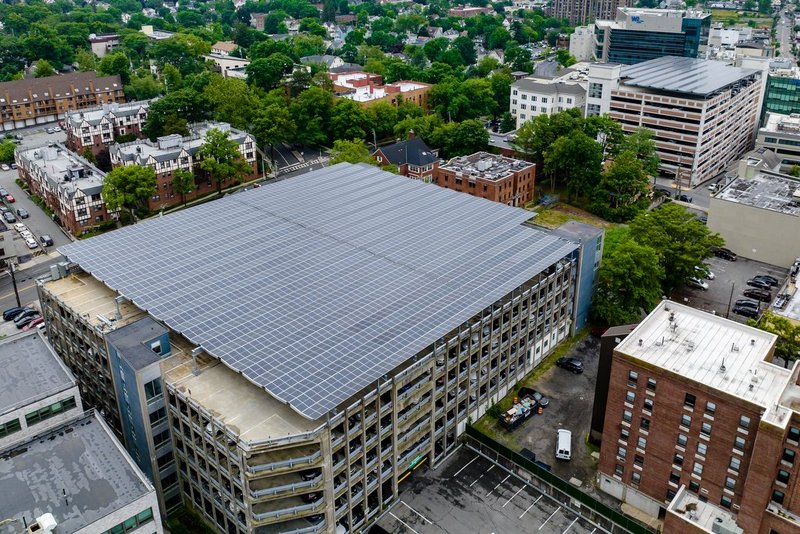How inverters are changing PV systems with bundled services

Tabuchi’s EneTelus is a 5.5-kW solar inverter accompanied with a 10-kWh lithium-ion storage battery.
Downsizing (or is it upsizing?)
Somehow, all of these new capabilities haven’t made these inverters too cumbersome. Several manufacturers are now offering their lightest versions to-date.
On the rooftop, the downsizing has ushered in a move away from traditional string inverters toward module level power electronics. “Installers and system owners overwhelmingly recognize the benefits of MLPE, from increased energy yield and design flexibility to improved safety and monitoring,” Handelsman says. “With this market evolution, we see that regulations are also shifting toward these technologies.”
Another example being a true three-phase, four-module microinverter from APsystems that is actually built for the commercial segment. APsystems microinverters provide a microinverter-to-module ratio of 1:2 (the YC500 residential microinverter) and 1:4 (the YC1000 commercial microinverter), meaning potential failure rates are halved or quartered by virtue of simple math.
WATCH: SolarEdge debuts streamlined HD-Wave inverter design
Hey, why stop there on the upscaling of smaller devices? Increased capabilities within a smaller package also have ramifications for the complex architecture of a massive utility-scale project.
“The major industry change has been the move from three-phase central inverters to three-phase string inverters for the commercial and utility-scale market,” says Natalie Holtgrefe, head of marketing for Yaskawa – Solectria. “We have seen a major shift in solar project development, where 50-MW-plus sites are being built with string inverters due to the improved quality and lower costs.”
Storage
A big part of solar’s second act (or is this the third act?) is the role storage will play, and here again, inverter innovations are crucial for achieving a system that works. Inverters are now designed for grid-tied energy storage to ensure that the batteries are full, that loads are supported and any excess is able to be sold to the grid.
Eaton was early with integrating storage.
“The attractive feature of an inverter is that it can respond to grid requirements in about 25 milliseconds. This is about 1,000 times faster than conventional generation,” Thompson says. “Utility projects with both solar and storage can provide features and responsiveness that are simply not achievable today with rotating generation.”
Tabuchi has a strong history of making grid- and user-friendly inverters in Japan and is now bringing that plug-and-play mentality into the solar-plus-storage space. Its inverter is easy to install because all of the components are contained in a single unit and are made to work together seamlessly, and the company has partnered with GELI software to make solar-plus-storage more grid-friendly. Utilities can now manage entire fleets of solar-plus-storage systems across a service area to maximize operational efficiency and slash costs.
“This allows our product to work well with time-of-use, self-consumption and demand charge rate schedules,” says Daniel Hill, director of sales and marketing for Tabuchi North America. “It also enables customers to control their systems from the cloud and connect with other smart home devices.”
The Sunny Boy from SMA has an exclusive Secure Power Supply feature that makes it possible for the inverter to provide up to 1,500 W of daytime standby power when the grid is down for charging laptops, cell phones and more, without the need of additional batteries.
SolarEdge and Fronius will be exclusive providers of the Tesla Powerwall when it makes its debut in 2016.
On a larger scale, Princeton Power Systems does a ton of projects with battery energy storage for grid-tied applications to reduce peak demand charges, which basically decreases LCOE by delivering extra value for the PV system.
RELATED: How energy storage helps solar’s long-term value problem
“We are also doing a lot with island systems with energy storage and reducing LCOE and increasing reliability for systems that rely on diesel generation,” says Darren Hammell, co-founder and chief strategy officer for Princeton Power Systems.
And this is just the beginning as a ton more inverter/storage integrations and partnerships are coming down the road. APsystems is presently developing on-grid battery backup systems that will allow end-users to realize utility cost savings in markets with tiered power pricing. “We are also applying our microinverter technology to integrated microgrid solutions,” says Christopher Barrett, director of technical services at APsystems.
The fifth generation of Enphase’s Microinverter System will be a fully integrated part of the Enphase Home Energy Solution, a flexible platform for the future of energy. Enphase delivers solar, storage and energy management technologies that not only optimize but also provide insight via bi-directional communication. It’s an integrated solution that includes microinverters, the Envoy Communications Gateway with built-in revenue-grade metering and available consumption monitoring and the Enlighten Software Platform. These will all integrate seamlessly with the Enphase Storage System which is coming to market in 2016.
So, other than all of that, not a whole lot going on in the inverter space.





